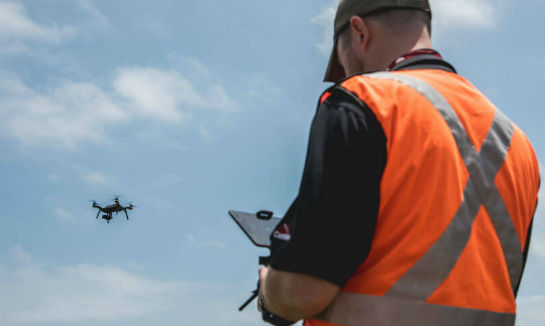
The test included up to 24 UAS that were remotely flown simultaneously at six FAA UAS test sites around the country. Texas A&M University-Corpus Christi Photo
Texas A&M University-Corpus Christi’s Lone Star Unmanned Aircraft Systems Center participated in the largest test yet of NASA’s UAS traffic management (UTM) research platform, on Tuesday, April 19.
The test included up to 24 unmanned aircraft systems (UAS), commonly called drones, that were remotely flown simultaneously at six Federal Aviation Administration (FAA) UAS test sites around the country.
In Texas, at Port Mansfield, about two hours south of Corpus Christi, four UAS took flight at 11 a.m. The three quad-copters and one small fixed-wing aircraft launched and landed at the regional airport.
“We had a series of operational flights at 11 a.m., noon, 1 and 1:30 p.m.,” said Jerry Hendrix, Lone Star UAS Center’s executive director. “All four times we did have aircraft in the air. And we had a report that there were 22 in the air simultaneously, so we consider it a success.”
This test boasts several firsts:
• First multi-site test of NASA’s UTM research platform;
• first coordinated test across all six FAA test sites;
• most simultaneous, live UAS flights under the UTM research platform;
• first UTM demonstration with live flights and simulated flights in the same scenario;
• first demonstration of several independent UTM research client implementations; and
• first live use of NASA-developed UTM displays and apps at each test site.
“The University is very proud to have our Lone Star UAS Center of Excellence and Innovation selected as one of the six approved FAA sites across the nation,” said Dr. Flavius Killebrew, president and CEO of A&M-Corpus Christi. “The purpose of these test sites is to develop ways to safely integrate UAS into the national airspace.
“Today’s mission is a very significant step toward that goal. In addition, the Credentialing Program developed by Lone Star and the Texas Engineering Experiment Station, ensures that novice operators are properly trained and equipped to fly UAS while still accomplishing the tasks necessary for them to enhance their business needs.”
Using the UTM platform, engineers at NASA’s Ames Research Center in Moffett Field, California, monitored the flights remotely from each of the six FAA test sites in Texas, Alaska, North Dakota, Nevada, New York, and Virginia. The Virginia site also had UAS launches in Maryland.
The purpose of this test was for operators from all six FAA test sites to interact with the UTM research platform at geographically diverse locations, using various aircraft and different software clients to test rural, within line-of-sight UAS operations so that NASA, in collaboration with the FAA, can obtain information to further refine and develop the research.
“This provides considerable data for (NASA) to assess their framework,” said Hendrix. “The Lone Star UAS Center looks forward to assisting NASA in the evaluation of unmanned traffic technologies.”
“Tests like this are critical to the safe integration of unmanned aircraft into the national airspace with piloted aircraft,” said Lone Star officials.
Mathew Nelson was one of the pilots of the UAS at the Texas site. “Using a traffic management framework to separate the aircraft and provide position awareness to air traffic control or to a mission commander helps us provide space between manned aircraft and unmanned aircraft and actually promotes the safety of integrating those two into the airspace,” he said.
The Lone Star Center and the other sites will participate in another similarly coordinated mission in October in Nevada to further test this research platform as it continues to develop.









